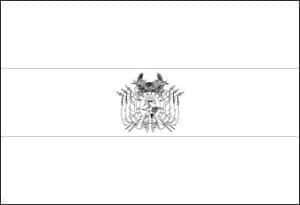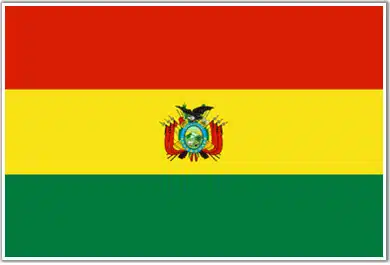
The Bolivia flag was acquired on 31st October, in the year of 1851. Prior to the Independence in Bolivia in the year of 1825, a number of flag diversities were found there.
The national flag of Bolivia, sometimes referred to as “The tricolour,” is made up of three equal-width horizontal stripes. Red, yellow, and green make up the top, middle, and bottom stripes, respectively. The National Coat of Arms is shown in the middle of the flag on a yellow stripe.
Yellow represents Bolivia’s richness and natural resources, while green represents the fertility of the land and crimson represents the bravery and bravery of Bolivian troops.
Facts about Bolivia flag |
| Country | Bolivia |
|---|---|
| Designed by | NA |
| Adopted | October 31, 1851 |
| Revision | NA |
| Design and Colors | A horizontal tricolor of red, yellow and green with the National Coat of Arms of Bolivia centered on a yellow band. |
| Size Ratio | 15:22 (Proportion) |
| Official Name: | Plurinational State of Bolivia |
| Proportion: | 15:22 |
| Adopted on: | October 31, 1851 |
| Location: | Central part of South America bordered by Brazil, Paraguay, Argentina, Chile, and Peru |
| Capital City: | La Paz (administrative capital), Sucre (constitutional capital) |
| Major Cities: | Santa Cruz de la Sierra, Beni, La Paz, Chuquisaca, Cochabamba |
| Area: | 424,163 square miles |
| Population: | 10,907,778 |
| Currency: | Boliviano (BOB) |
| Official Languages: | Spanish, Aymara, Quechua |
| National Anthem: | Himno Nacional de Bolivia |
| National symbol(s): | llama, Andean condor |
| National colors: | red, yellow, green |
| National anthem: | |
| Name: | “Cancion Patriotica” (Patriotic Song) |
| Lyrics/Music: | Jose Ignacio de SANJINES/Leopoldo Benedetto VINCENTI |
Historical Background
The current design of the Bolivia flag, the Wiphala, is a relatively recent creation, officially adopted on October 25, 2009. However, its origins date back to pre-colonial times when indigenous peoples used a similar design in their textiles and other artifacts.
Design and Colors
The Bolivia flag, or Wiphala, consists of a square-shaped flag with seven horizontal stripes of different colors. The colors used in the Wiphala are white, red, orange, yellow, green, blue, and purple. The stripes are arranged from top to bottom, with each color occupying equal space.
Symbolism of the Bolivia Flag
Each color in the Wiphala holds significant symbolism, representing different aspects of Bolivia’s cultural and historical heritage. The white color symbolizes the Andean snow and the concepts of time and eternity. The red color represents the earth, the indigenous people’s struggle, and the power of the collective community. The orange color symbolizes the society’s cultural values and the aspiration for well-being. The yellow color represents the nation’s resources and the energy of its people. The green color symbolizes natural resources and agriculture. The blue color represents the natural resources, and the purple color symbolizes the indigenous cultures and their spirituality.
FAQs
Q1: When was the current design of the Bolivia flag adopted?
The current design of the Bolivia flag, the Wiphala, was officially adopted on October 25, 2009.
Q2: What do the colors on the Bolivia flag represent?
The white color represents the Andean snow and eternity, the red symbolizes the earth and the indigenous people’s struggle, the orange represents cultural values and well-being, the yellow symbolizes the nation’s resources and energy, the green represents natural resources and agriculture, the blue symbolizes more natural resources, and the purple represents indigenous cultures and spirituality.
Q3: How should the Bolivia flag be handled and displayed?
The Bolivia flag, the Wiphala, should be treated with respect and dignity. The proper protocol should be followed when hoisting, lowering, and displaying the flag to recognize its importance to the indigenous communities.
Q4: What is Bolivian National Day?
Bolivian National Day, also known as Día del Estado Plurinacional, is celebrated on January 22nd each year. It commemorates the founding of the Plurinational State of Bolivia and celebrates the country’s multicultural identity, represented by the Wiphala.

